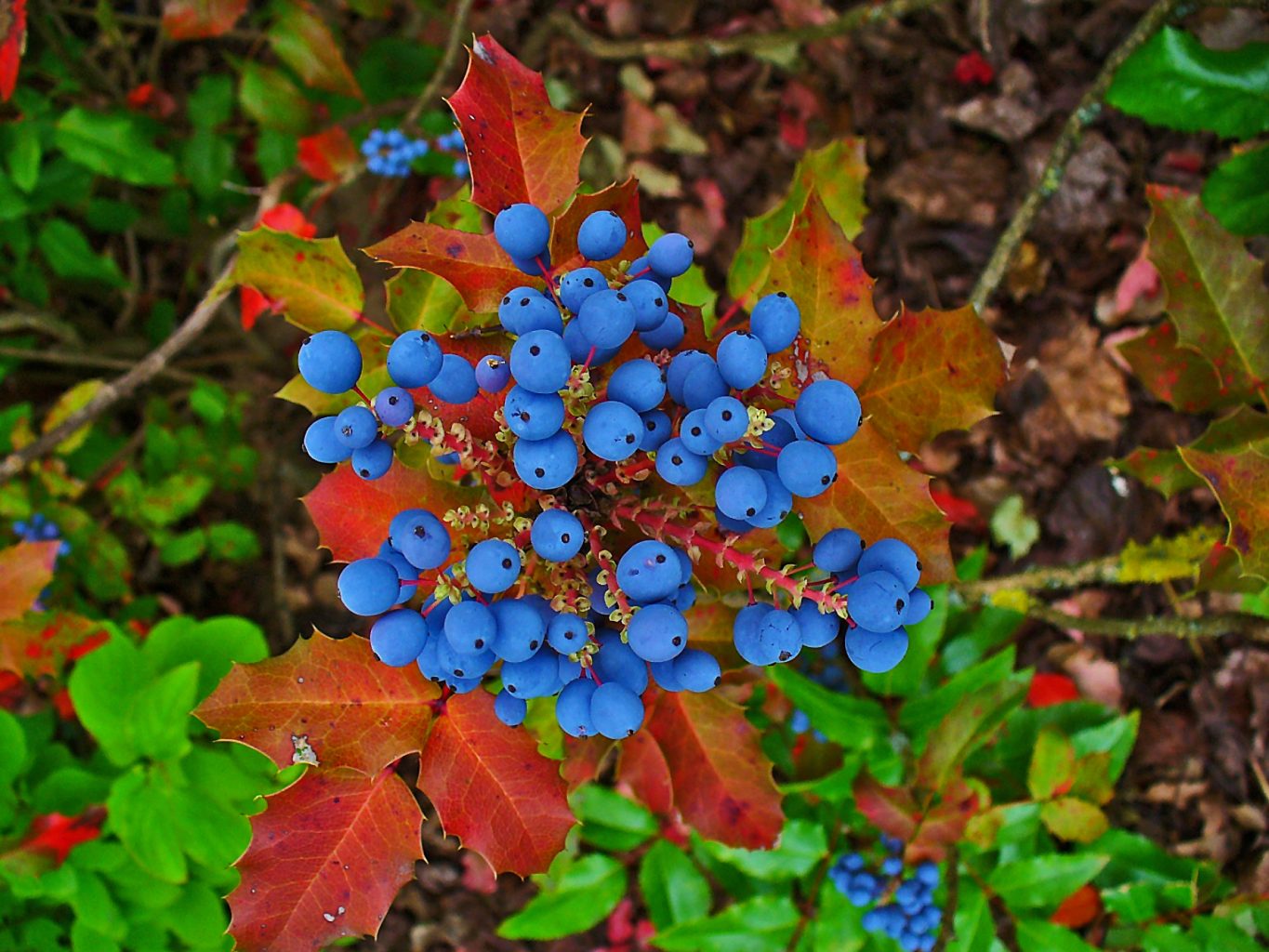
by Tammera J. Karr, PhD
For those who live in the Pacific Northwest, especially in the mountainous areas, we are familiar with the holly-like shrub with yellow blossoms and purple berries clusters – Oregon Grape (Mahonia aquifolium) or also known as mountain grape, and holly-leaved barberry. As the name might indicate, it is also the state flower for Oregon. The golden yellow roots, however, is where the medicinal qualities are highest and the portion most commonly harvested by wildcrafters and herbalists. The root is traditionally prepared in one of two methods – either steeping the root to create a tea or using the root to create a tincture.
This prickly shrub has a long history as a medicinal plant as well as a food source in the Native American tradition. Oregon grape has been used for skin ailments, herpes, acne, hepatitis, upper respiratory congestion, STD’s, arthritis, fever, gallbladder conditions, liver and eye ailments. According to WebMD, Oregon grape is used for stomach ulcers, gastroesophageal reflux disease (GERD), stomach upset, as a bitter tonic, to treat infections, and to cleanse the bowels.
Oregon grape root is renowned among herbalists for its ability to stimulate liver function, improve the flow of bile, and for blood cleansing. Containing a number of alkaloids and because of this, it has a very bitter taste Oregon Grape root can take some getting used to if taken straight. Taste aside, the positive benefits of these alkaloids far outweigh the brief discomfort and bitter taste. In China, where Oregon grape root is substituted for the herb coptis, studies have shown one of the alkaloids the plant contains, berbamine, can help strengthen bone marrow and assist chemotherapy and radiation patients in their recovery – not bad for a little shrub grown in the Pacific Northwest.
According to traditional and modern herbal sources, the bitterness of Oregon Grape also has a positive effect on the digestive tract. This herb has a sedative effect on the smooth muscles lining the digestive tract and stimulates the flow of bile, which loosens waste in the gut and helps prevent constipation, stomach cramps, diverticulosis, hemorrhoids, gallbladder disease, and irritable bowel syndrome.
Native American healers often use the stem of the tall Oregon Grape over the root of the dwarf variety. When berberine content is checked with a chromatograph, we see the wisdom of this practice. The stem contains a slightly higher berberine level and is less labor intensive to prepare. With dwarf plants digging washing and pealing are involved with the preparation of the herb. The use of stems from the tall Oregon grapes allows for one plant to provide decades of berberine collection without killing the plant.
While the medicinal qualities of the berries do not match that of the bark, they do however make a wonderful jelly. The berries are used to make jelly, wine, and juice. However, Oregon grape berries are quite tart, and it is customary to blend them with sweeter salal, and huckleberries. Deep blue-berries are usually ripe from July to September. In the same way, fine wine carries complex flavors, Oregon grape is earthy and rich with undertones of cherry, raspberry, and lemon. This wild food makes grape jelly pale in comparison. We always look forward to cornbread from a cast-iron skillet slathered with Kerry Gold Butter and a generous blop of Oregon Grape Jelly.
How to Making Oregon Grape or Elderberry Jelly
6 cups cleaned Oregon grape berries (or wild elderberries with these we are less picky about stems and leaves)
Place berries in a 4-8 quart stainless stockpot with 2 cups of water.
Bring contents to a boil, then turn down and simmer for 15 minutes. Use a potato masher, or immersion blender to mash berries releasing the juice.
Place a Foley food mill over a second stockpot. In 1 to 2 cup increments, turn the berries and juice through the food mill to separate the seeds. Remove the seeds from the mill before straining another batch.
Once finished, measure your juice/pulp. It should yield about 3 cups. Add a little water to bring your volume to 3 cups if necessary.
In a large pot (jelly and jam like to splash so we use a 6-quart pan to reduce mess) on the stove top, add 3 cups juice, 1 ounce of Certo (about ½ of a liquid package) or Ball pectin and the juice of ½ lemon. Stir well to incorporate pectin. Increase heat, stirring consistently to prevent scorching.
Bring juice to a rapid boil once more, add 3 cups organic sugar, return to a rolling boil – boil for exactly 1 minute. Any longer and you will have rock candy.
Remove from the burner.
Place the jelly in clean hot ½ pint canning jars, wipe the top of the jars clean, cover with lids, and can in a water bath for 10 minutes. If any lids do not seal, refrigerate for up to three weeks.
Sources
1. Mosby’s Handbook of Herbs & Natural Supplements 3rd edition by Linda Skidmore-Roth pp789-793
2. Pacific Northwest Foraging by Douglas Deur, Timber Press pp 38-39, 147-148
3. Plants of the Pacific Northwest Coast by Pojar and Mackinnon, Lone Pine Press pp 95
4. Cardiovascular Effects of Berberine: A Review of the Literature, Journal of Restorative Medicine, Volume 6, Number 1, 6 December 2017, pp. 37-45(9);
5. Baseline of Health Foundation, Oregon Grape Root
6. Mountain Rose Herbs
7. Medical Uses for Oregon Grape
8. Methowvallyherbs.com
9. Wild Foods and Medicines
Check Out Our Online Course
Let’s Begin the Journey of a Lifetime!